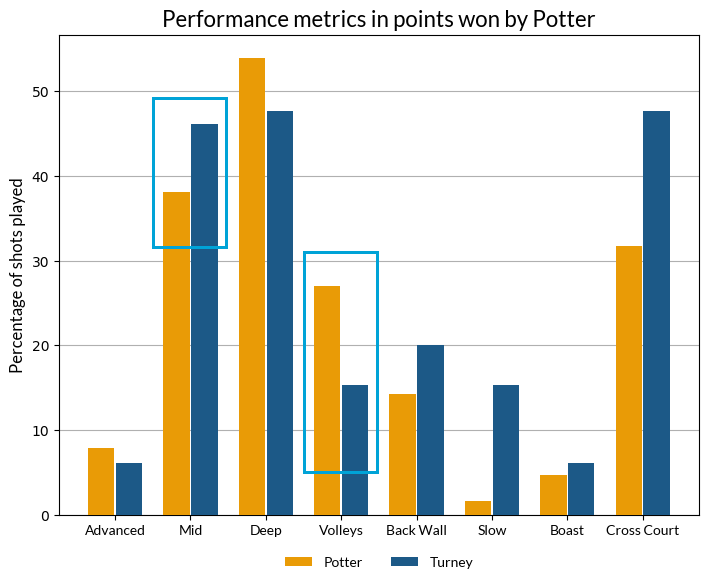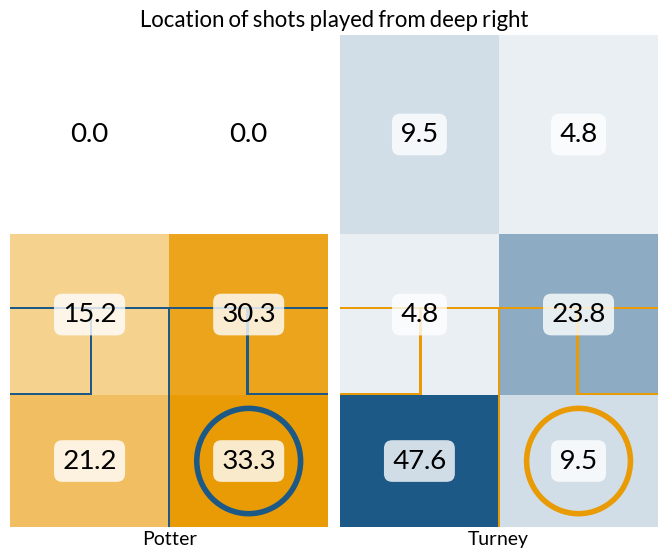SquashSkills has teamed up with stats company Cross Court Analytics to provide a data-driven angle to the Coaches Corner game reviews. In this piece, Cross Court take a look at the stats behind Game 1 of Mike Potter vs Jack Turney and pick out some observations which caught their eye.
Watch: Coaches Corner with Nick Matthew analysing Mike Potter
Watch: Coaches Corner with Tania Bailey analysing Jack Turney
Looking at the overall picture of shot location and shot type metrics, below, a few things leap out. First of all, Turney hit many more shots from mid-court than Potter did – often a sign of controlling a Game. Potter, by contrast, hit almost two-thirds of his shots from behind the service boxes (what we at Cross Court term ‘deep’). And while both players volleyed and made use of the back wall equally often, it is notable how often Turney opted to slow the pace of the rally and hit the ball cross-court.

Turney’s high number of shots from mid-court and Potter’s frequent hitting from deep are reflected neatly in the players’ shot location heatmap. Turney, in blue, hit many of his shots from within the backhand service box, while at the same time forcing Potter to retrieve from deeper on court, restricting the latter’s options to attack and generally maintaining a commanding position in front of his opponent. Turney won the first Game 11-8.

The importance of shots played from mid-court become apparent when considering performance metrics in points won by Potter. As depicted in the first chart (above), throughout Game 1 Potter (34%) hit far fewer shots from mid-court than Turney (51%). In points Potter won, however, this margin reduces dramatically: in those rallies he won, Potter hit 38% of shots from mid-court, a 4 percentage point increase on his match average, and reduced Turney’s shots from mid-court to 46%.

While this shift may seem small, it appears Potter’s hitting from mid-court facilitated another aspect of his game: volleying. Throughout Game 1, Potter hit 18% of shots on the volley, fractionally less than Turney’s 19%. Looking only at the points which brought him success, however, and Potter hit a high 27% of shots on the full, and reduced Turney’s volley rate from 1 in 5 to 1 in 7. Potter may have lost the Game, but when he was able to press high and hit a high number of (often mid-court) volleys – the performance metrics equivalent of ‘controlling the T’ – he dictated the match.
With this data to hand, our between Game advice to Potter would have been purely encouraging: when playing well, he had the shots and the game-plan to beat Turney.
If Turney’s success was accompanied by forcing Potter deep, how did he do it? Zooming in to shots played from certain regions is revealing. Throughout Game 1, Turney was particularly adept at sending Potter to the backhand graveyard with forehand shots from mid-court (depicted in blue on the right-hand side of the chart below). Of the shots that Turney hit from mid-right, he hit 60.7% to deep on Potter’s backhand. Potter, by contrast, could only force Turney deep left from the same position every three shots (34.5%).

This constant build-up of back-court pressure undoubtedly paved the way for Turney’s win. Potter, though, hit 48.2% of shots from mid-right back to the mid-court, too high a number to ever exert lasting control of the Game.
From mid-left, however, the numbers tell a different story. As shown in the chart below, with mid-court backhands both players hit to deep ~50% of the time, and both hit to mid 4 times out of 10. Our advice to Potter would have been, if in doubt, to keep the ball down the left wall: while Turney exerted significant control when hitting mid-court forehands, the players’ hitting profiles from mid-left were similar.

One interesting element revealed in the chart above is that Turney didn’t leave a single shot short on Potter’s backhand. While one Game is a small sample size, that would be one angle for both coaches to look into more closely.
One aspect in which Potter and Turney differed significantly was in the number of times they elected to hit cross- court. As seen in the first chart of match performance metrics, Turney hit half of his shots cross-court, while Potter hit cross-court only every third or fourth shot. The biggest discrepancy emerges when considering shots from the backhand graveyard. Potter hit an enormous 85.0% of his shots from deep left down the line. Turney, by contrast, was less predictable, and much happier to switch the location of exchanges from deep on the backhand to deep on the forehand (35.4%).

A similar story plays out from deep on the forehand. Turney again made Potter turn and retrieve from the backhand, while Potter elected to hit the forehand channel.

When considering both players’ shots from deep locations, it is also readily apparent how reluctant both players were to take the ball short. The only exception was Turney’s relative readiness to boast from the forehand graveyard, a shot he attempted 3 times from the 21 shots he played from this region. Potter hit just 1 forehand boast from deep in the 33 shots he played from this region. A small sample size, of course, but something worth monitoring.

As seen in the chart below, Turney (12.8%) opted to slow the pace of rally – for instance by lifting from the front or employing a high, slow drive from the back – far more readily than Potter (3.9%). This may have been part of Turney’s game plan to lengthen the rallies against an older opponent.

But it is worth noting that Potter held his own in the longer rallies: both players won 2 of the 4 rallies over 30 shots in length. Nor did Potter appear to suffer in those rallies immediately following a lengthy exchange – so often the endurance player’s reward: in rallies immediately after a rally of 25 shots or more, Potter won 2 and Turney won 4. The effect of such a tactic might appear later in the match, but for now, Potter was Turney’s equal in physicality

Turney won the Game 11-8. His ability to play from in front of Potter – hitting a high number of shots from mid-court and forcing Potter to play from deep – went a long way to ensuring this. His keenness to turn Potter by hitting cross-court, and extend the rallies with tempo-slowing shots might point towards a game plan of keeping his opponent on court. With a clear idea of what brought him success, the stats tell Turney to keep doing what he’s doing.
As a final observation for Potter, let’s consider Turney’s shots from short on the forehand. Of the 3 shots Turney played from this region, he hit all 3 down the line with pace. Might there be some mileage in Potter bringing Turney forward here, and setting himself for the shot down the line? A couple of easy strokes for Potter to start Game 2 may well rattle his opponent.
For more stats, blogs, and information about how you can use Cross Court Analytics’ match report service, check out their website, Twitter or Facebook.
